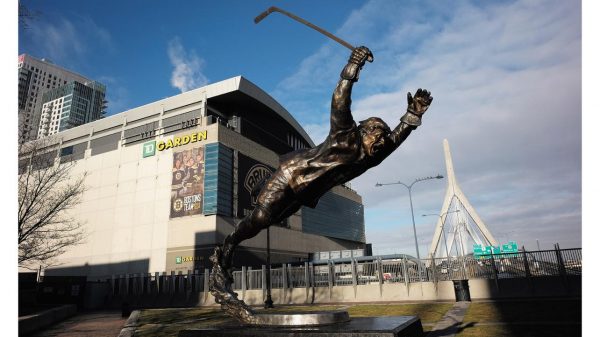
By: Amy Tolman | Follow me on Twitter @amy7594
On January 9, 1979, the Boston Bruins honored Bobby Orr by retiring his number four and raising it to the rafters amongst other retired numbers worn by great legends in Bruins history. Playing since he was a young boy, it was in his future to be an icon in hockey, and he accomplished just that. We start with a video from YouTube that shows his ceremony at the Boston Garden.
Bruins hockey scouts discovered Orr at age 12 and gave him a junior amateur contract. In 1966, he signed with the Bruins at the legal age of 18 and played for them for ten years. Orr’s first professional contract was the first in professional ice hockey to be negotiated by an agent. It made him the highest-paid player in National Hockey League history as a rookie. Through the pre-season, Orr wore jersey number 27. Orr’s junior number was two, but it was retired in honor of Eddie Shore. The Bruins offered him jersey number five, which was Bruins star Dit Clapper’s number before the regular season. Orr instead chose jersey number four, which had been vacated by veteran defenceman Albert Langlois. Orr made his NHL regular-season debut on October 19, 1966, against the Detroit Red Wings. On October 22, he scored his first NHL goal against the Montreal Canadiens. It was a slap shot past Gump Worsley, and the Boston Garden crowd gave Orr a standing ovation
In his ten years with Boston, Orr contributed to eight consecutive playoff runs and two Stanley Cup Championships (1970, 1972). In both victories, Orr scored the game-winning goal and was named the playoff MVP. He acquired 16 NHL significant awards during his career, including being the only defenseman who won the league scoring title with two Art Ross Trophies. However, because Orr was frequently injured, Boston traded him to the Chicago Blackhawks in 1976. There he served as an assistant coach during the 1976–77 season.
Career Achievements
Orr accomplished many records and achievements, several of which still stand today and are listed below. As of the end of the 2018–19 season:
First and only defenceman to score nine hat tricks
First defenceman to score 30 goals (1969–70) and 40 goals (1974–75) in a season.
The first player to record 100 assists in a season (1970–71)
Only defenceman to win the Art Ross Trophy as the league leader in scoring (1969–70, 1974–75)
Only defenceman to win the Lester B Pearson Award
Only player ever to win the Norris Trophy, Art Ross Trophy, Hart Trophy, and Conn Smythe Trophy in one season (1969–70)[49]
Highest single-season plus-minus rating, +124 in 1970–71
Fourth in league history in career point-per-game average, all-time, (1.393) (highest among defensemen, minimum 500 career points)
Sixty-sixth overall in league history in career assists and tied for 109th in career points
Wikipedia
One Of Bruins Most Iconic Sports Moments
On May 10, 1970, at the Boston Garden, the Boston Bruins led the St. Louis Blues in the Stanley Cup finals series three games to zero. The game that night was tied at three, and the game went into overtime. A mere 40 seconds into the extra period, Orr works a give-and-go with forward Derek Sanderson and takes the puck to the net. Orr beats Blues goaltender Glenn Hall just as he’s getting tripped by defenceman Noel Picard. Airborne and victorious, the most outstanding defenceman to play the game flings his arms to the heavens in celebration of his first Stanley Cup victory, and it was also the Bruins’ first in 29 years. It was Game 4, period 4, number 4 scoring while being tripped by number 4.
A Tribute

A bronze statue of Orr stands next to Boston’s TD Garden, the Bruins’ home arena. It was unveiled on May 10, 2010, the 40th anniversary of the Bruins’ first Stanley Cup victory with Orr, and depicts him immediately after scoring the winning goal. The unveiling ceremony was attended by Orr and several of his former teammates.
In The End
Orr retired in 1979, the same year that he was inducted into the Hockey Hall of Fame. The Hockey Hall of Fame waived the standard three-year waiting period for induction into the Hall. Orr was age 31, the youngest player living at the time of his inauguration in history. He was the eighth player to have the three-year period waived, the next two being Mario Lemieux in 1997 and Wayne Gretzky in 1999. The Hall of Fame then decided that the three-year waiting period rule for any player would no longer be waived except under “certain humanitarian circumstances.”


Leave a Reply